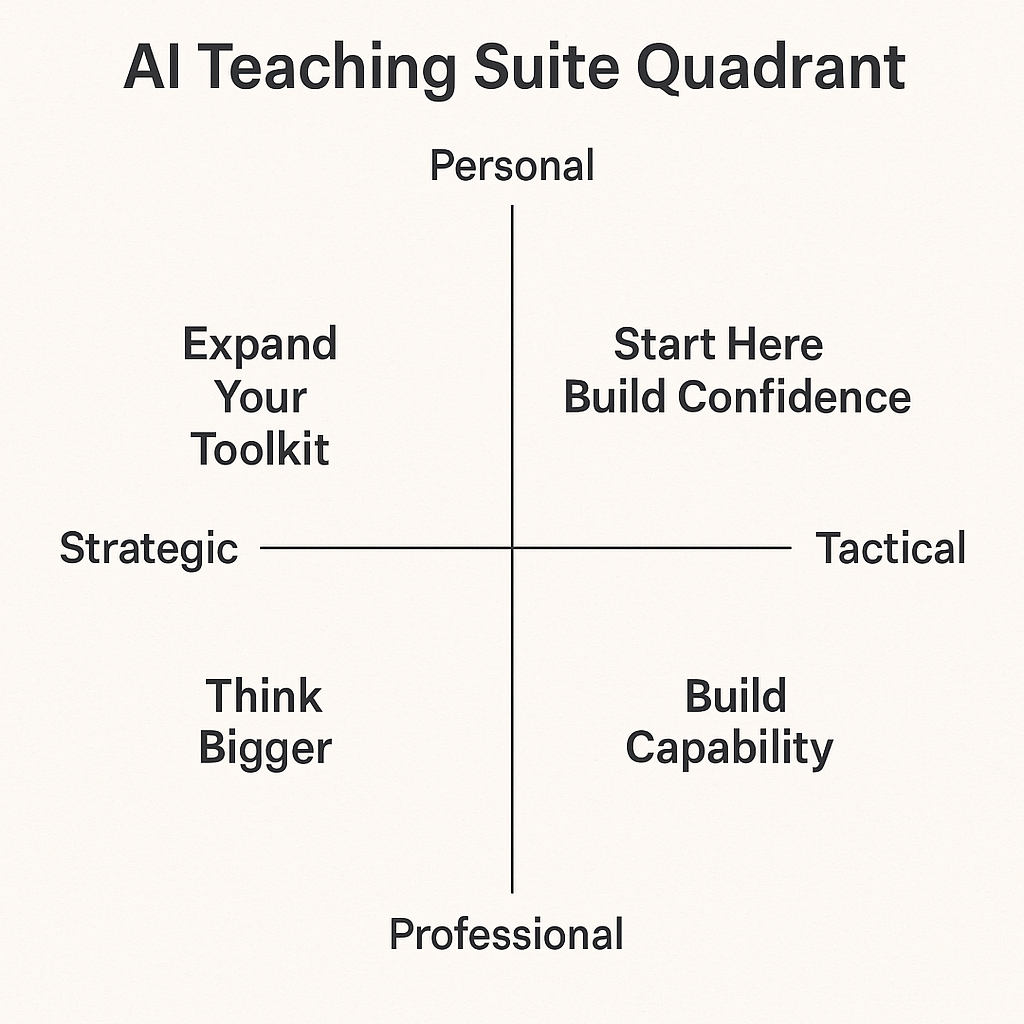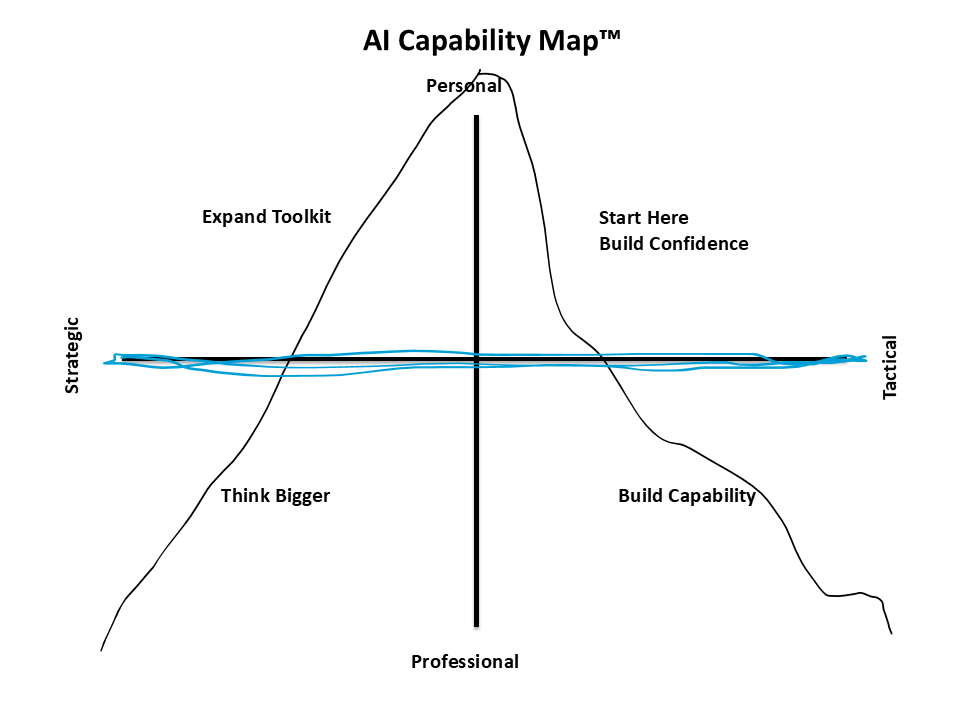AI Teaching Suite™
Practical tools to build your confidence and capability with generative AI – one step at a time.
Generative AI is more than a trend – it’s becoming a thinking partner. It helps leaders ask better questions, surface sharper insights, and work more effectively.
But where do you begin?
The AI Teaching Suite™ is a structured set of resources designed to help leaders, consultants, educators, and researchers move from AI curiosity to confident, impactful use.
Each post is practical, standalone – and together, they’re organised using the AI Capability Map™ – a quadrant-based model that guides your learning across four clear domains.
Whether you’re starting from scratch or expanding your toolkit, you’ll find a path that fits your needs.

The AI Capability Map™
I use a quadrant-based model to structure learning: the AI Capability Map™. It helps you navigate from personal exploration to professional application – and from strategic insight to practical action.
It’s built on two simple axes:
• Personal → Professional
• Strategic → Tactical
Together, they create four learning zones, each with a clear purpose.
Scroll down to explore – and check back soon for a companion series exploring the bigger picture.
Understanding the Learning Journey
The AI Capability Map™ isn’t just a model – it reflects a natural progression in learning.
From early exploration to deep integration, each quadrant helps you build the skills, mindset, and insights needed to thrive with AI.
Here is a summary of the four learning zones:
Quadrant 1 – Build Confidence
Exploration – explore AI safely
Start small, experiment safely, build personal comfort and curiosity with AI.
Quadrant 2 – Build Capability
Application – apply it at work
Use AI meaningfully in your real work – to save time, extend reach, and get more done.
Quadrant 3 – Think Bigger
Reframing – reframe your mindset
Shift your mindset. See AI as a thinking partner – not just a tool, but a collaborator.
Quadrant 4 – Expand Your Toolkit
Breakthrough – use advanced tools
Go further with advanced techniques like context engineering and smarter tool selection.
Quadrant 1: Start Here – Build Confidence
Start small. Stay safe. Build early confidence.
These posts are designed to help you take your first steps with clarity and curiosity – unlocking curiosity without overwhelm, and progress without pressure.
You’ll notice that most of the posts in Quadrant 1 focus on ChatGPT. That’s intentional. For many people, their first steps into generative AI happen through a conversational chatbot like ChatGPT – and OpenAI’s tool remains the most widely used entry point globally.

While these posts highlight ChatGPT – in particular, the paid version, ChatGPT Plus – the core learning applies to any large language model (LLM), including Claude (Anthropic), Gemini (Google), Grok (xAI), or DeepSeek (High-Flyer AI). The tools may vary – the underlying skills and mindsets don’t.
Overcoming the Dick Tracy Barrier
A simple but powerful way to reframe AI. This post helps you move past hesitation and see generative AI not as a gimmick, but as a genuine thinking partner.
ChatGPT Plus for Beginners
A clear, friendly walkthrough of how to get started with ChatGPT Plus. No jargon. No overwhelm. Just practical steps.
Using Projects in ChatGPT: Your AI Workspace for Longer-Form Thinking
Use ChatGPT Projects to organise, revisit, and build on your thinking – ideal for research, writing, and strategic reflection.
Talking to Think: Voice Input and Voice Mode in ChatGPT
Voice changes how you think with AI. Learn how to use voice-to-text and Voice Mode in ChatGPT to capture ideas, reflect more clearly, and work faster — with structure and flow.
Understanding Memory in ChatGPT
Memory in ChatGPT isn’t what most people think. Learn what it does, what it doesn’t, and how to use it with clarity — especially when working across sessions or models.
Tokens, Context Limits, and Why Your AI Chat Sometimes Forgets
Speaking is faster than typing – but how you speak to AI matters. This post explores two powerful voice input options inside ChatGPT and when to use each.
Quadrant 2: Build Capability
You’ve found your footing. Now it’s time to apply what you’ve learned.
This is where AI shifts from curiosity to contribution – a genuine productivity partner helping you streamline tasks, save time, and support real work with real impact.
Prompt with Purpose: How to Use the CRAFT Model to Get Better Answers
The CRAFT model helps you get better answers from any LLM (think ChatGPT). Learn how to prompt with purpose using five simple elements: Context, Role, Ask, Format, and Target Audience. Works across multiple use cases.
AI Boosters for Busy Managers
Five fast ways managers can use AI to save time, reduce noise, and improve clarity — from summarising meetings and drafting emails to rehearsing difficult conversations and clarifying strategy.
Agent Mode in ChatGPT: A Smarter Way to Get Things Done
Agent Mode turns ChatGPT into a task-based assistant. Learn what it is, how to activate it, and when to use it — for research, analysis, planning, and more.
Projects + Agents: A Smarter Way to Manage Research, Consulting, and Complex Thinking
Projects organise your work. Agent Mode completes the task. Learn how to use both together in ChatGPT for smarter thinking, clearer structure, and faster progress across research and consulting.
Quadrant 3: Think Bigger
You’ve put AI to work – now it’s time to shift how you think.
This quadrant invites you to go beyond tools and tasks. When you move from prediction to partnership, AI becomes a collaborator – opening space for deeper insight, creativity, and shared thinking.
From Prediction to Partnership
Discover how shifting from AI-as-output to AI-as-partner unlocks powerful new ways of thinking, collaborating, and solving problems.
Working with AI in Leadership & Culture
We’ll explore how AI is transforming leadership and culture – and what it means to lead and learn in an AI-shaped world.
Seeing with AI: How Generative Tools Expand Perspective
AI can help us think in 360 degrees – not just from one viewpoint. This post explores how generative tools unlock broader, deeper understanding.
Not Just Faster, but Deeper: Human + Machine Thinking
When AI augments our thinking, we don’t just speed up – we dig deeper. This post explores how high-tech and high-touch can coexist.
Quadrant 4: Expand Your Toolkit
You’ve shifted your mindset – now it’s time to sharpen your methods.
This quadrant introduces more advanced techniques, like context engineering and smarter tool selection. The magic happens here – but only if you’ve walked the path.
This is where experimentation meets insight, and practice turns into mastery.
Context Engineering: Why Briefing AI Matters
This is where the magic happens. Learn how to give AI better context – and why thoughtful, structured inputs often matter more than clever prompts.
Beyond CRAFT: Exploring Other Prompting Models
CRAFT is a great starting point – structured, practical, and easy to apply. But it’s not the only game in town. Explore other prompting frameworks and syntax patterns that help you adapt, refine, and elevate your AI interactions as your confidence grows.
Which AI for Which Task?
Feeling overwhelmed by AI options? This guide helps you choose the right tool for the job – without needing to be a tech expert.
Custom GPTs for Research & Consulting
Explore how to create your own AI assistants with ChatGPT’s custom GPTs – tailored to your work, your language, and your goals.

Above the Line and Below the Line
The AI Capability Map™ also draws on the classic iceberg model:
-
- What’s above the waterline is visible – confidence, curiosity, experimentation
- What’s below the waterline is transformative – capability, application, impact
Together, these dimensions help explain why starting with safety matters – and why deeper engagement is where the true shift begins.

Why I Built the AI Teaching Suite™
I’ve spent the last 40 years working with leaders in high-risk industries, unionised workplaces, and complex organisational environments. Over the past two years, I’ve been using generative AI in my research, consulting, and writing – and teaching others to do the same.
This suite captures what I’ve learned:
-
-
What’s useful
-
What’s overhyped
-
And how to apply AI in ways that amplify human achievement
-
This is not about replacing people. It’s about enabling better thinking, sharper reflection, and faster decision-making – while keeping the human firmly in the loop.
How to Use This Page
Each quadrant is a step in the learning journey:
Explore → Apply → Reframe → Breakthrough.
Start anywhere – each post is practical and self-contained.
However, following the arc leads to real mastery.
Bookmark the page. It updates as new posts are released.
Coming Soon: AI Insight & Impact
A new companion series is on the way. While the AI Teaching Suite™ focuses on practical how-to skills, this upcoming series explores the bigger questions – from ethics to economics, from education to the future of work.
Perfect for leaders, researchers, and curious thinkers who want to understand not just how to use AI – but why it matters.
Looking for a starting point?
Try Post Zero – Overcoming the Dick Tracy Barrier
A simple but powerful way to reframe AI. This post helps you move past hesitation and see generative AI not as a gimmick, but as a genuine thinking partner. A perfect place to begin – especially if you’re still finding your footing.
A downloadable version of the full suite is coming soon.
Workshops and briefings are available through Lifting Impact (launching soon).
Stay curious.
Work wisely.
Build confidence with AI.
